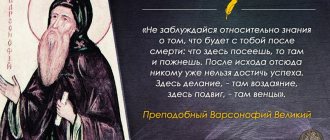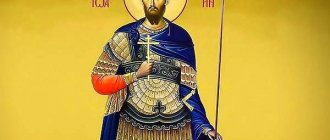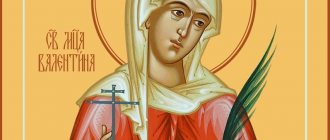| Holy Apostle and Evangelist John the Theologian |
John the Theologian
(+ c. -117), holy apostle and evangelist Commemoration of May 6 (Antiochus-Zap. [1]) - memory of torment in boiling oil at the Latin Gate in Rome c. 56-68, May 8 - remembrance of the miraculous procession on the grave of the finest ashes, June 20 - transfer of relics [2] (Greek [3]), September 26 - repose, as well as in the Councils of the Twelve Apostles, Dodecanese Saints (Greek. ), Patmos saints (Greek) [4]
He was the son of Zebedee and Salome, daughter of Saint Joseph the Betrothed. At the same time as his older brother Jacob, he was called by Jesus Christ to be one of His disciples on Lake Gennesaret. Leaving their father, both brothers followed the Lord.
The Apostle John was especially loved by the Savior for his sacrificial love and virginal purity. After his calling, the apostle did not part with the Lord and was one of the three disciples whom He especially brought close to Himself. Saint John the Theologian was present at the resurrection of the daughter of Jairus by the Lord and witnessed the Transfiguration of the Lord on Tabor. During the Last Supper, he reclined next to the Lord and, at a sign from the Apostle Peter, leaning against the Savior’s chest, asked about the name of the traitor. The Apostle John followed the Lord when He, bound, was led from the Garden of Gethsemane to the trial of the lawless high priests Annas and Caiaphas, but he was in the bishop's courtyard during the interrogations of his Divine Teacher and relentlessly followed Him along the Way of the Cross, grieving with all his heart. At the foot of the Cross, he wept together with the Mother of God and heard the words of the Crucified Lord addressed to Her from the height of the Cross: “Woman, behold Thy son,” and to him: “Behold Thy Mother” (John 19:26-27). From that time on, the Apostle John, like a loving son, cared for the Blessed Virgin Mary and served Her until Her Dormition, never leaving Jerusalem.
After the Dormition of the Mother of God, the Apostle John, according to the lot that fell to him, went to Ephesus and other cities of Asia Minor to preach the Gospel, taking with him his disciple Prochorus. They set off on a ship that sank during a strong storm. All travelers were thrown onto land, only the Apostle John remained in the depths of the sea. Prochorus wept bitterly, having lost his spiritual father and mentor, and went to Ephesus alone. On the 14th day of his journey, he stood on the seashore and saw that a wave had thrown a man onto the shore. Approaching him, he recognized the Apostle John, whom the Lord had kept alive for two weeks in the depths of the sea. The teacher and student went to Ephesus, where the Apostle John constantly preached to the pagans about Christ. His preaching was accompanied by numerous and great miracles, so that the number of believers increased every day.
At this time, the persecution of Christians began under Emperor Nero (56-68). The Apostle John was taken to Rome for trial. For confessing faith in the Lord Jesus Christ, the Apostle John was sentenced to death, but the Lord preserved His chosen one. The apostle drank the cup of deadly poison offered to him and remained alive, then emerged unharmed from the cauldron of boiling oil, into which he was thrown on the orders of the tormentor. After this, the Apostle John was sent into captivity on the island of Patmos, where he lived for many years. Along the way to the place of exile, the Apostle John performed many miracles. On the island of Patmos, a sermon accompanied by miracles attracted all the inhabitants of the island to him, whom the Apostle John enlightened with the light of the Gospel. He cast out numerous demons from idol temples and healed a great many sick people. The Magi, through various demonic obsessions, offered great resistance to the preaching of the holy Apostle. The arrogant sorcerer Kinops, who boasted that he would bring the apostle to death, especially frightened everyone. But the apostle, by the power of God’s grace acting through him, destroyed all the demonic tricks that Kinops hoped for, and the proud sorcerer died ingloriously in the depths of the sea.
The Apostle John retired with his disciple Prochorus to a deserted mountain, where he imposed a three-day fast on himself. During the apostle’s prayer, the mountain shook and thunder roared. Prokhor fell to the ground in fear. The Apostle John raised him up and ordered him to write down what he would say. “I am Alpha and Omega, the firstfruits and the end, says the Lord, who is and who is and who is to come, the Almighty” (Rev. 1:8), proclaimed the Spirit of God through the holy Apostle. So, about a year later, the Book of Revelation (Apocalypse) of the holy Apostle John the Theologian was written. This book reveals the secrets of the fate of the Church and the end of the world.
After a long exile, the Apostle John received freedom and returned to Ephesus, where he continued his work, teaching Christians to beware of false teachers and their false teachings. About a year later, the Apostle John wrote the Gospel in Ephesus. He called on all Christians to love the Lord and each other and thereby fulfill the commandments of Christ. The Church calls Saint John the Apostle of Love, for he constantly taught that without love a person cannot approach God. The three Epistles written by the Apostle John speak about the meaning of love for God and neighbors. Already in old age, having learned about a young man who had strayed from the true path and become the leader of a gang of robbers, the Apostle John went to look for him in the desert. Seeing the holy elder, the culprit began to hide, but the apostle ran after him and begged him to stop, promising to take upon himself the young man’s sin, if only he would repent and not destroy his soul. Touched by the warmth of the holy elder’s love, the young man truly repented and corrected his life.
The Holy Apostle John died at the age of over a hundred years. He far outlived all the other eyewitnesses of the Lord, for a long time remaining the only living witness of the earthly paths of the Savior.
| Repose of the Ap. John. Fresco from the Church of Christ Pantocrator. Decani, Kosovo, Serbia (c. 1350) |
When the time came for the Apostle John to depart to God, he withdrew outside of Ephesus with seven of his disciples and ordered a cross-shaped grave to be prepared for himself in the ground, in which he lay down, telling the disciples to cover him with earth.
The disciples kissed their beloved mentor with tears, but, not daring to disobey, fulfilled his command. They covered the saint's face with a cloth and buried the grave. Having learned about this, the rest of the apostle’s disciples came to the place of his burial and dug up the grave, but found nothing in it. Every year on May 8, thin pink dust emerged from the grave of St. John the Apostle, which believers collected and were healed of illnesses with. Therefore, the Church celebrates the memory of the holy Apostle John the Theologian on May 8th. The Lord gave his beloved disciple John and his brother the name “sons of thunder” ( Boanerges
) - a messenger of heavenly fire, terrifying in its cleansing power. By this the Savior pointed to the fiery, fiery, sacrificial nature of Christian love, the preacher of which was the Apostle John the Theologian. The eagle is a symbol of the high soaring of Theological thought - the iconographic sign of the Evangelist John the Theologian. Of the disciples of Christ, the Holy Church gave the title of Theologian only to Saint John, the seer of the Destinies of God.
John the Theologian occupies a special place among the chosen disciples of Christ the Savior. Often in iconography, the Apostle John is depicted as a meek, majestic and spirit-bearing old man, with features of virginal tenderness, with the stamp of complete calm on his forehead and the deep gaze of a contemplator of ineffable revelations. Another main feature of the spiritual appearance of the apostle is revealed through his teaching on love, for which he primarily received the title of Apostle of Love. Indeed, all his writings are permeated with love, the main idea of which boils down to the concept that God in His being is Love (1 John 4:8). In them he dwells primarily on the manifestations of God’s inexpressible love for the world and man, on the love of his Divine Teacher. He constantly exhorts his disciples to love each other. The service of Love is the entire life path of the Apostle John the Theologian.
He was characterized by calmness and depth of contemplation combined with ardent loyalty, tender and boundless love with ardor and even some harshness. From the brief instructions of the Evangelists it is clear that he had an extremely ardent nature, his heartfelt impulses sometimes reached such violent jealousy that Jesus Christ was forced to moderate them as disagreeing with the spirit of the new teaching (Mark 9, 38 - 40; Luke 9 , 49 - 50; Luke 9, 54 - 56). At the same time, he showed rare modesty and, despite his special position among the apostles as a disciple whom Jesus loved, he did not stand out from the number of other disciples of the Savior. The distinctive features of his character were observation and receptivity to events, imbued with a subtle sense of obedience to the will of God. Impressions received from outside were rarely found in his word or action, but penetrated powerfully and deeply into the inner life of the holy Apostle. Always sensitive to others, his heart ached for those who were perishing. The Apostle John listened with reverent awe to the God-inspired teaching of his Teacher, filled with grace and truth, contemplating in pure and sublime love the Glory of the Son of God. Not a single feature from the earthly life of Christ the Savior escaped the penetrating gaze of the Apostle John, not a single event passed without leaving a deep trace in his memory, therefore the entire fullness and integrity of the human personality was concentrated in him. The thoughts of the Apostle John the Theologian had the same integrity. For him there was no duality. According to him, where there is no complete devotion, there is nothing. Having chosen the path of serving Christ, he pursued it with completeness and undivided consistency until the end of his life. The Apostle John speaks of complete devotion to Christ, of the fullness of life in Him, therefore he views sin not as weakness and corruption of human nature, but as evil, as a negative principle, completely opposite to good (John 8:34; 1 John 3, 4; 1 John 3, 8 - 9). In his opinion, one can belong either to Christ or to the devil; there can be no middle, indefinite state (1 John 2:22; 1 John 4:3). Therefore, he served the Lord with undivided love and dedication, rejecting everything that belonged to the original enemy of man, the enemy of truth and the founder of lies (1 John 2:21 - 22). The more he loves Christ, the more he hates Antichrist; the more he loves the truth, the more he hates lies - light excludes darkness (John 8:12; John 12:35 - 36). With this manifestation of the inner fire of love, he testified with special strength of spirit about the Divinity of Jesus Christ (John 1:1-18; 1 John 5:1-12).
The Apostle John was destined to express the last word of Divine Revelation, introducing the innermost secrets of the inner Divine life, known only to the eternal Word of God, the Only Begotten Son. The truth is reflected in his mind and word, because he feels and comprehends it with his heart. He contemplates the eternal Truth and, as he sees it, passes it on to his beloved children. The Apostle John simply affirms or denies and always speaks with absolute accuracy (1 John 1:1). He hears the voice of the Lord, revealing to him what He Himself hears from the Father.
The theology of the Apostle John destroys the boundary between the present and the future. Observing the present, the temporal, he does not dwell on it, but transfers his gaze to the eternal in the past and to the eternal in the future. And therefore, calling for holiness of life, he solemnly proclaims that “whoever is born of God will not sin” (1 John 5:18; 1 John 3:9). In communion with God, a true Christian participates in the Divine life, therefore the future of humanity is already taking place on earth. In presenting and revealing the doctrine of the Economy of Salvation, the Apostle John the Theologian moves into the realm of the eternally present, in which Heaven has descended to earth and the renewed earth is illuminated by the Light of Heavenly Glory.
So the Galilean fisherman, the son of Zebedee, became the Theologian, who through Revelation announced the secret of the world and the fate of mankind.
Biography
The Apostle John, later called John the Theologian, was known as a particularly beloved disciple of Christ. Jesus emphasized the sacrifice and spiritual purity of John, and therefore John became one of the apostles especially close to Christ.
Apostle John
The Lord Himself nicknamed John “Son of Thunder.” Hearing the call of the savior, the boy left his home and rushed after the Preacher. It was John who fell to the chest of Jesus at the last meal of Christ, and later in the texts of the books he proved that the Lord personifies love.
Writings of an Apostle in the New Testament
The Apostle is traditionally credited with the authorship of five books of the New Testament: the Gospel of John, the 1st, 2nd and 3rd epistles of John and the Revelation of John the Theologian (Apocalypse). Some researchers dispute the authorship of the apostle. The apostle received the name John the Theologian because of the naming of Jesus Christ in the Gospel of John as the Word of God.
According to the sequence of gospel events according to the four evangelists (paragraphs 21 and 141), the Apostle John describes the expulsion of the merchants from the temple four years earlier (on the first Easter of four) (John 2:13) before the conversation with the Samaritan woman (John 4:9) , and all the other three evangelists describe this event on the last - fourth Easter: (Matthew 21:12-13), (Mark 11:15-19), (Luke 19:45-46).
Childhood and youth
Church literature claims that the family of the Apostle John traces its origin back to King David. The betrothed husband of the Blessed Virgin Mary, Joseph the Carpenter, had a daughter, Salome, who married Zebedee. Salome and Zebedee had two sons: James and John.
Young Apostle John
Evangelist Mark mentions in the writings that John, his older brother James and his father were fishing from a boat when the call of Christ sounded. The brothers left their catch and their father and followed the Lord. Luke in the writings adds that the newly minted apostles were present at the miraculous fishing and, impressed, turned to the Savior. The young men did not doubt their choice for a moment: they left everything they had and followed the Teacher.
For his impulsive character, keen sense of justice and masterful use of words, Christ nicknamed John the Theologian “Son of Thunder.” These features clearly manifested themselves during the ninth and last walk of the Lord through Galilee: Jesus wanted to go to Jerusalem, but before that he sent messengers to the Samaritan village.
Apostle brothers James and John
However, the residents of the settlement did not accept the Savior. Then John and his brother Jacob asked Christ if they could call fire from heaven to punish the inhabitants of the Samaritan village, but the Lord stopped the excited apostles, because Jesus brings salvation to people, not punishment.
The Apostle John, together with his brother James, were especially close to Peter and were considered closest to the Lord.
Christian service
Once on the shore of the Sea of Galilee, Christ preached a sermon to the people. Among other people, the chairman of the local Synagogue, Jairus, approached Jesus and told the Savior that his daughter was dying. The Lord went to Jairus’ daughter to heal her. On the way to Jairus's house, the messenger told Christ that the girl had died, but Jesus followed her and raised the girl. Only 3 of the 12 apostles witnessed this miracle: Peter, James and John.
John the Theologian
In addition, John the Theologian is the only one of the apostles who was at the Life-Giving Cross. There Jesus instructed John to take care of the Virgin Mary as if he were his own mother.
It is traditionally believed that John the Theologian became the author of five books of the New Testament. The fourth book of the New Testament is called the Gospel of John, although scholars now express doubts about the authorship of the book. For a long time, John preferred oral sermons, but after writing the Gospel of Mark and Luke, John was increasingly asked about the early deeds of the Teacher, which he outlined in his book.
Later, for a wide circle of believers, “The First Council Epistle of the Holy Apostle John the Theologian” was written, which was also included in the New Testament. It is interesting that this book also does not formally have an author, although he is attributed to John the Theologian. The style of speech, the use of phrases and thoughts, as in the Gospel of John, allows us to attribute the book to the authorship of the Apostle John. The book dates back to approximately 90 AD.
John the Evangelist writes the Bible
The book is based on the theme of love in its broadest sense. Moreover, the apostle John shows Jesus as the Word of God. Chapter 5 of the work contains the first mention of the Holy Trinity in the history of Christianity in the following formulation: “Father, Word and Holy Spirit,” supporting its vision of God the Son (Jesus) with the Word.
However, researchers who have studied the “First Conciliar Epistle of the Holy Apostle John the Theologian” point out that this thought does not belong to the author, but is an insertion made much later in order to establish the doctrine of the Trinity. On the pages of the “Message” the author tried to convey the main idea about the unity and inseparability of God and love.
John the Evangelist hugs Jesus Christ
The authorship of the shortest book of the New Testament also belongs to John. The book is called “The Second Council Epistle of the Holy Apostle John the Theologian.” Considering that on the pages of the “Epistle” the author calls himself an elder, and the work dates back to the 90s of the 1st century AD, as well as the similarity of style with previous books, allows scientists to attribute the book to the works of the Apostle John.
In meaning and content, the second “Message” repeats the first, but in a much more abbreviated form. The work focuses on brotherly love between Christians and a call to be wary of the harmful influence of false teachings. Particular attention is drawn to the dedication of the “Epistle” to the “beloved lady,” but researchers agree that this name refers to a community of Christians.
Apostles John and Peter
“The Third Conciliar Epistle of the Holy Apostle John the Theologian” in general terms repeats the previous books both in style and in subject matter. It is noteworthy that the Roman historian Eusebius of Caesarea, describing the history of the Christian church, never mentions the presence in the New Testament of the “Third Council Epistle of the Holy Apostle John the Theologian.”
The first mention of the book dates back to the second half of the 4th century AD, after the Council of Laodicea, dedicated to issues of church government and Christian piety. In particular, Rule 59 prohibits reading biblical books that are not included in the biblical canon of the Old and New Testaments. In the list given in the next rule, the “Third Council Epistle of the Holy Apostle John the Theologian” appeared. However, researchers do not doubt the authorship of the book.
Jesus Christ and the Apostle John
In addition, the “Third Council Epistle of the Holy Apostle John the Theologian” is no longer dedicated to Christian communities in general, but specifically to Gaius. However, the identity of Gaius, to whom the book is dedicated, has not been established. Also, more than once in the “Message” a certain Diotrephes is mentioned, holding a high position in the Church. The actions of Diotrephes, who did not accept wandering Christians and even threatened them with “administrative punishment” up to and including excommunication, were condemned by John the Theologian.
The book of the Revelation of Jesus Christ, also known as the Apocalypse of John or the Revelation of John the Theologian, also belongs to the pen of John the Theologian. This work completes the New Testament. Unlike all previous books of John, the Apocalypse reveals the theme of events that will precede the Second Coming of Jesus Christ to earth. Among such events, the author mentions both natural disasters (fire falling from heaven, etc.) and miracles (appearances of angels, resurrection of dead people).
Icons of John the Evangelist
Also in the Apocalypse, the author more than once mentions his name - John, and also talks about the events that he witnessed. While on the small Greek island of Patmos in the Aegean Sea, John heard a voice from behind, ordering him to write in a book what he saw. In this regard, the authorship of the Apocalypse is sometimes attributed to John of Patmos, who, however, is identified with John the Theologian.
However, researchers argue about the authorship of “Revelation”, since the style and language of the book differ significantly from the “Conciliar Epistles” and the Gospel. However, Metropolitan Hilarion explains this fact by the fact that the author was faced with the need to write about the realities of the New Testament in the language and symbols of the Old Testament.
In addition, the German theologian and researcher of Christianity Wilhelm Busse conducted an analysis of the texts, as a result of which he established that the syntax and lexical phrases correspond to the earlier texts of John the Theologian, thereby confirming his authorship. A Russian researcher who worked on the interpretation of the texts of Holy Scripture, Alexander Pavlovich Lopukhin, also agreed with Busse.
John the Evangelist in a cauldron with hot oil
Modern researchers still question the fact that the “Apocalypse of John” was written by John the Theologian. Thus, in the book of the Archpriest of the Russian Orthodox Church Alexander Vladimirovich Me “Reading the Apocalypse”, as well as Donald Guthrie’s “Introduction to the New Testament”, the idea is clearly visible that among the apostles there were at least 3 Johns, who later merged into a single collective image.
Details of the biography of John the Theologian became known from church writings. After the death of the Virgin Mary, John became a preacher, traveling through the cities of Asia Minor, accompanied by a disciple named Prochorus. Considering that the sermons of John the Theologian were often accompanied by miracles, there were more and more converts to Christianity.
When the Roman Emperor Nero began persecuting Christians, John was arrested and sent to Rome. The court decided to execute the preacher, however, after drinking poison, John remained alive. Then the judges decided to put the apostle in a cauldron of boiling oil, but even then John the Theologian remained unharmed. Then the old preacher was sent into exile to the island of Patmos in the Aegean Sea, accompanied by a disciple.
John the Evangelist on the island of Patmos
The ship on which John, his disciple and the nobles were sailing was caught in a storm, and the noble young man fell overboard. The apostle prayed for a long time about the fate of the young man, and in the morning the waves carried him to the shore alive and unharmed.
Arriving on the island, the Apostle John converted most of the inhabitants to Christianity, performing a number of miraculous healings, and also cast out demons from the pagan temples on the island. A preacher lived with his disciple in a cave far from people, where he indulged in prayer. There, more than once John heard the voice of the Lord commanding him to write books for the glory of God. The local sorcerer Kinops also lived on the island, converting the inhabitants to paganism. After the prayer of John the Theologian, the waves of the Aegean Sea swallowed Kinops forever, and the rest of the local residents converted to Christianity.
What was John's last journey?
The only one of the apostles who saw the terrible persecution, survived it and died a natural death, wrote the Good News to his descendants, leaving a testimony of True love - John the Theologian. With the advent of Emperor Nerva to the Roman throne, who replaced the evil Domitian, all prisoners were released.
John returned to Ephesus, where he lived in the house of Dorn, who had been resurrected by him, baptized people, preached the Word of God, healed and resurrected by the power of the Blood of Jesus.
Jesus prophetically predicted Peter's martyrdom, emphasizing that each apostle had his own destiny. The disciples thought that the Savior promised immortality to John, but the Lord said that he would not die.
According to historical information, the apostle lived for a hundred years; there is no description of his burial, but legends say that the still living John was buried alive at his request by his disciples. After opening the grave some time later, everyone found it empty. It is possible that, like Enoch and the prophet Elijah, the beloved disciple was taken to Heaven alive.
Important! On October 8, the day the saint was buried, the smell of incense was heard over the place of his grave, indicating the presence of the prophet among the living. The Orthodox Church celebrates October 9 as the day of veneration of John the Theologian.
Memory
Even during his lifetime, John the Theologian was honored in the church. Thus, on the icon “John the Theologian in Silence,” the apostle is depicted with an Angel conveying to him the Word of the Lord, and on the pandatives of Orthodox cathedrals the Saint is depicted with an eagle, which symbolizes the soaring thought of the apostle.
Icon “John the Theologian in Silence”
Among the exploits of the Apostle John, church traditions tell about the resurrection by John of the young man Domnus and his father Dioscorides. In addition, at a festival dedicated to the pagan goddess Artemis, John accused those gathered of worshiping idols and called sizzling heat on their heads, causing the death of 2 hundred people. By faith and the will of the Apostle, the dead were resurrected and accepted Christianity.
The memory of the Apostle John the Theologian is revered on May 8 and June 30 annually. This holiday is named after the Council of the Twelve Apostles. On September 26, Orthodoxy celebrates the repose of John the Theologian (Catholics celebrate December 27). On the day of memory of John the Theologian, divine services are held in churches, and a candle burns with imperishable light, illuminating the path to heaven, in memory of the apostle. At the service, the clergy remember the life of John the Theologian and glorify his exploits.
Troparion, Kontakion and Canon to the Holy Apostle and Evangelist John the Theologian
Troparion, tone 2:
The beloved Apostle of Christ God, trying to deliver unrequited people, accepts the bot, falling down, even as he reclines on his chest. Pray to the Theologian for the impending pagan rebuke, as if to disperse a cloud, asking us for peace and great mercy.
Kontakion, voice 2:
Who will confess your greatness as a virgin; You pour forth miracles, and pour out healings, and pray for our souls, as the Theologian and friend of Christ.
Library of the Russian Faith Canon to the Holy Apostle John the Theologian →
Read online











